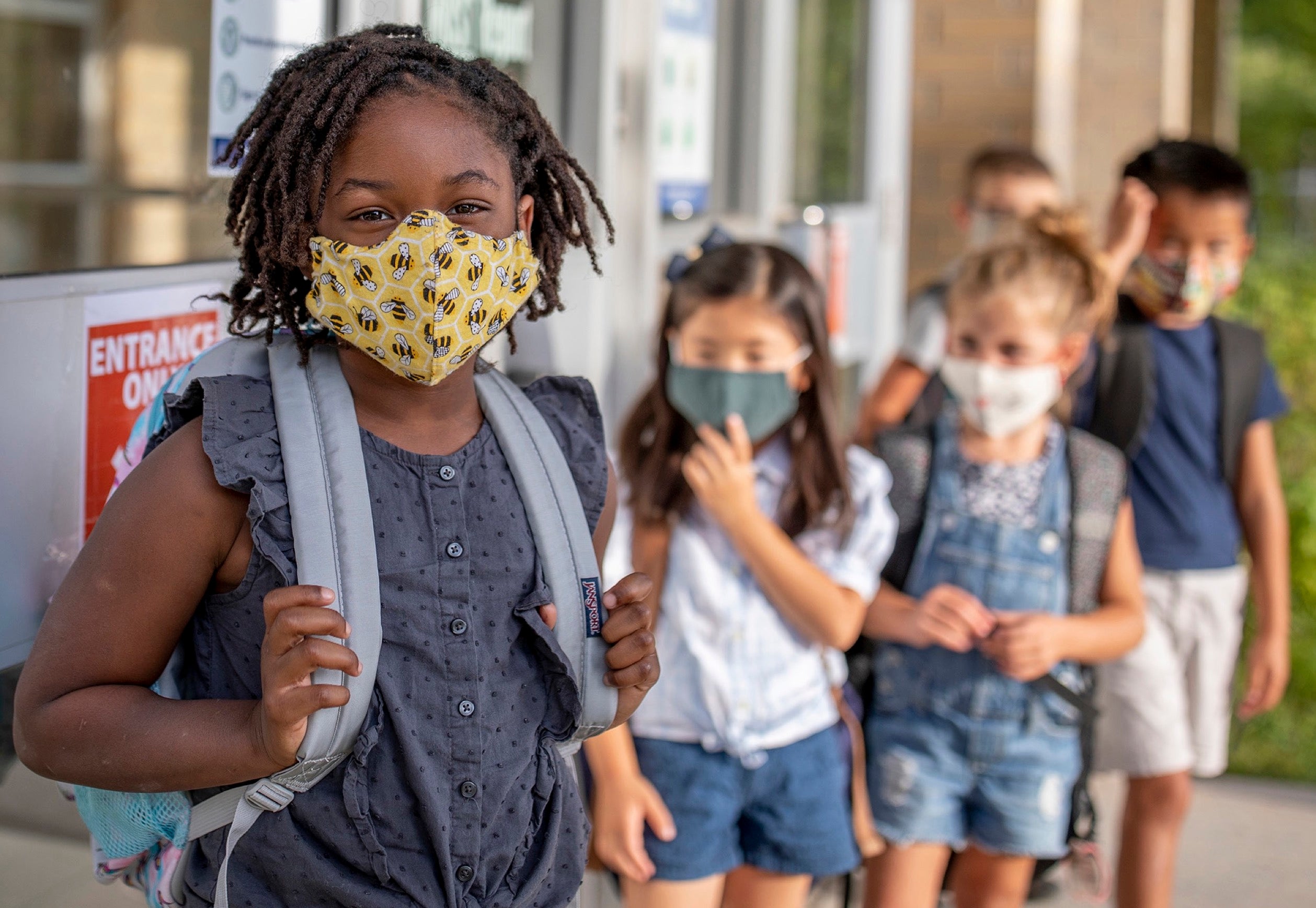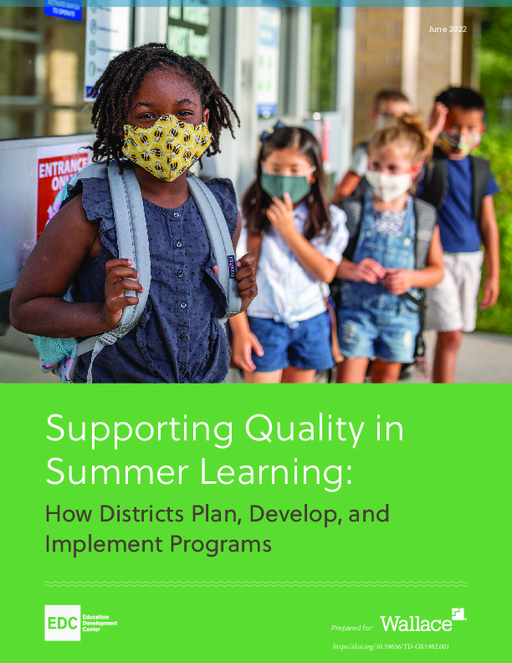Breadcrumb
- Wallace
- Reports
- Supporting Quality In Summer Lea...
Supporting Quality in Summer Learning
How Districts Plan, Develop, and Implement Programs

- Author(s)
- Leslie Goodyear, Tony Streit, Alyssa Na’im, Katrina Bledsoe, Meghan Broadstone, Katari Coleman, Sara Greller, Tracy McMahon, Sheila Rodriguez, Heidi Rosenberg, and Salma Shawa
- Publisher(s)
- Education Development Center, Inc.
Summary
How we did this
This study drew upon both the foundational and primary research to better understand how districts make decisions about summer learning initiatives and what supports they use to ensure those initiatives are high quality. The researchers conducted online research and reviewed relevant literature, which informed their understanding of the articulated needs, gaps, and issues facing summer learning programs. Primary research included interviews with district contacts, 21st CCLC state leads, and other state-level respondents in fall 2020 and in spring 2021.
School district-led summer programs play a critical role in supporting students academically and providing them with enriching experiences. This report looks at the policies, practices, and resources that go into the planning, development, and operation of these programs.
Key Findings
Districts prioritize academics, but recognize the importance of engaging, accessible programs.
Programs are commonly tied to local or state policies like elementary reading and literacy initiatives. Other aims include social and emotional learning, safe environment, fun activities, links to community resources, and enrichment opportunities. To promote equitable access to their programs, many districts offer supports and services such as transportation, food, and afternoon care.
Partnerships and collaborative decision-making was a consistent theme for summer programs.
Coordination of summer programs is complex. It involves coordination among district staff and numerous stakeholders. Community partners can play an essential role in supporting district-led programs. They can offer expertise in youth development, social and emotional learning, outreach to families, and recruitment. They can also provide students with enrichment activities, academic content, and mentorship. In the study, some districts struggled to develop mutually beneficial arrangements.
Educators and staff have access to a variety of professional development, yet there remain unmet needs in key areas.
Districts seek to be responsive to the needs of their communities and consult with program staff and teachers when prioritizing specific topics for professional development. Common topics include literacy, supports for students with special needs, and racial justice and equity. Areas of greatest need include student and staff mental health and well-being, trauma-informed practices, social and emotional learning, and diversity, equity, and inclusion.
Challenges
Respondents described a variety of challenges affecting their districts and summer learning programs.
Lack of transportation. This commonly cited barrier was described in two ways: (1) the city or town itself did not have proper public transportation systems in place or (2) the program was unable to properly fund transportation to ensure student attendance.
Equitable access to programming. Multiple respondents described challenges related to ensuring students who need the most support attend summer programming. However, support looks different depending on the district and school population. For some, concerns centered on issues like affordable childcare while others were concerned about enrollment criteria that unintentionally excludes students who could benefit from summer programming (for example, homeless students or students living with relatives during the summer).
Funding. Funding affects program quality, access, and opportunity for students and families. Respondents also expressed concerns regarding stability and predictability of funding.
Addressing student and family needs. Several respondents noted that engaging effectively with families was challenging. The most frequently mentioned topics were language and cultural barriers. Respondents also acknowledged that it takes time and money to intentionally nurture the school-family relationship.
Staffing. Staffing-related challenges included the lack of competitive wages, turnover, teacher burnout, and staff rejuvenation (making sure they have enough of a break over the summer so that they’re rejuvenated for the following academic year).
District-community partnerships. Some district leaders grappled with having strategic conversations with partners about how to have a mutually beneficial partnership. Building trust with partners takes time.
COVID-19
The authors describe how districts adapted their approach to summer learning in response to COVID-19 and suggest that states could use the influx of federal pandemic relief aid to invest in transportation, staff, and community partnerships for districts’ summer learning programs.

We may, truly, be at the point of a bold rebirth for summer learning—a time for it to be more central to the public education commitment we make to our children and families.
Key Takeaways
- Overall, district leaders are striving to provide meaningful summer programs to students. They recognize summer as an important time to reinforce and extend school-year learning while offering enrichment activities and opportunities not available during the school year.
- High-functioning, mutually beneficial partnerships between school districts and community-based organizations can support the success of summer learning programs.
- Districts take a variety of approaches, weaving funding and tailoring partnerships to best serve the needs of various schools and communities.
- Despite the significant threats of the pandemic during summer 2020, many districts resumed programming in 2021.
- States should consider using federal pandemic relief funding to invest in transportation, staff, and community partnerships for district-led summer learning programs. Significant federal investments can serve to bolster districts’ efforts for years to come.
Visualizations
21st CCLC Program Support for Summer Programs
The 21st CCLC state offices conduct a competitive grant process for their subgrantees. Each section of the application contributes to a total number of points (typically 100), and a state can include points for priority investment areas, such as summer programming. Overall, the researchers found that at least 16 21st CCLC state offices prioritize summer programming in some way: They either required such programming or offered points for it.
Materials & Downloads
What We Don't Know
- What are some characteristics of successful district-community partnerships? What are some barriers to effective partnerships?
- How can district leaders use evidence-based approaches to engage families and communities, particularly those from groups that have been historically marginalized?

